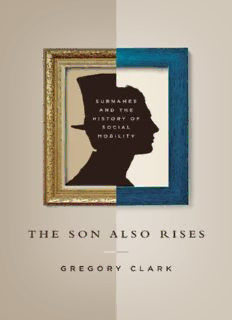
The Son Also Rises: Surnames and the History of Social Mobility PDF
Preview The Son Also Rises: Surnames and the History of Social Mobility
THE SON ALSO RISES THE PRINCETON ECONOMIC HISTORY OF THE WESTERN WORLD Joel Mokyr, Series Editor A list of titles in this series appears at the back of the book. THE SON ALSO RISES SURNAMES AND THE HISTORY OF SOCIAL MOBILITY GREGORY CLARK Neil Cummins, with Yu Hao, and Daniel Diaz Vidal and Tatsuya Ishii, Zach Landes, Daniel Marcin, Firas Abu-Sneneh, Wilfred Chow, Kuk Mo Jung, Ariel M. Marek, and Kevin M. Williams PRINCETON UNIVERSITY PRESS Princeton and Oxford Copyright © 2014 by Princeton University Press Published by Princeton University Press, 41 William Street, Princeton, New Jersey 08540 In the United Kingdom: Princeton University Press, 6 Oxford Street, Woodstock, Oxfordshire OX20 1TW press.princeton.edu Jacket design by Faceout Studio. All Rights Reserved Library of Congress Cataloging-in-Publication Data Clark, Gregory, 1957– The son also rises : surnames and the history of social mobility / Gregory Clark. pages cm.—(The Princeton economic history of the Western world) Includes bibliographical references and index. ISBN 978-0-691-16254-6 (hardcover : alk. paper) 1. Social mobility—History. I. Title. HT612.C53 2014 305.5′1309—dc23 2013042815 British Library Cataloging-in-Publication Data is available This book has been composed in Minion Pro with Maestrale display by Princeton Editorial Associates, Inc., Scottsdale, Arizona. Printed on acid-free paper. ∞ Printed in the United States of America 10 9 8 7 6 5 4 3 2 1 To Mary CONTENTS Preface ix 1 Introduction: Of Ruling Classes and Underclasses: The Laws of Social Mobility 1 PART I Social Mobility by Time and Place 2 Sweden: Mobility Achieved? 19 3 The United States: Land of Opportunity 45 4 Medieval England: Mobility in the Feudal Age 70 5 Modern England: The Deep Roots of the Present 88 6 A Law of Social Mobility 107 7 Nature versus Nurture 126 PART II Testing the Laws of Mobility 8 India: Caste, Endogamy, and Mobility 143 9 China and Taiwan: Mobility after Mao 167 10 Japan and Korea: Social Homogeneity and Mobility 182 11 Chile: Mobility among the Oligarchs 199 12 The Law of Social Mobility and Family Dynamics 212 13 Protestants, Jews, Gypsies, Muslims, and Copts: Exceptions to the Law of Mobility? 228 14 Mobility Anomalies 253 PART III The Good Society 15 Is Mobility Too Low? Mobility versus Inequality 261 16 Escaping Downward Social Mobility 279 Appendix 1: Measuring Social Mobility 287 Appendix 2: Deriving Mobility Rates from Surname Frequencies 296 Appendix 3: Discovering the Status of Your Surname Lineage 301 Data Sources for Figures and Tables 319 References 333 Index 349 PREFACE T HIS BOOK WILL BE CONTROVERSIAL. So the first task of this preface is to establish that while those listed on the title page collaborated on estimates of social mobility rates in various societies, the text itself was written by me. The interpretation of the evidence from these studies, and the proposed theory of mobility presented in the book, all represent my opinion alone. Also, none of the people I thank below should be taken as endorsing the conclusions of the book. My second task is to note that the spirit and style of this book follow those of my earlier book, A Farewell to Alms: A Brief Economic History of the World. It tries to show that extraordinarily simple models of social mobility can successfully predict outcomes across a whole range of societies and institutions. This is a claim based on incomplete evidence. It may be wrong. But even if it is wrong in aspects, I hope it will point the way to a better and more complete theory of the mechanisms of social mobility. Even in an area as freighted with aspirations and disappointments as social mobility, there should still be room for exploration and conjecture. The work discussed in this volume was undertaken with several collaborators. The most extensive collaboration was with Neil Cummins, who is jointly responsible for most of the material in chapters 4 and 5 on England. The chapter on China and Taiwan reports on the work Yu Hao completed for his graduate dissertation here at the University of California, Davis, where he devised the methods needed to deal with the small numbers of Han Chinese surnames. The chapter on Chile is a
